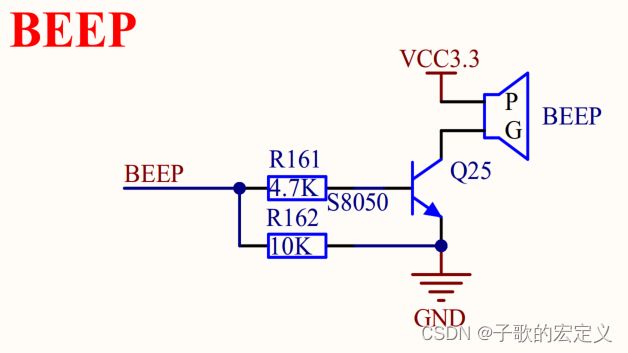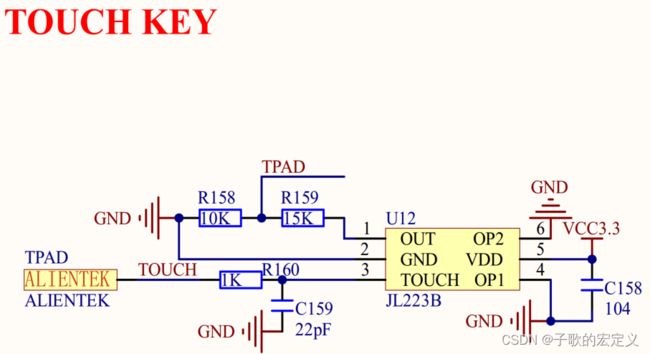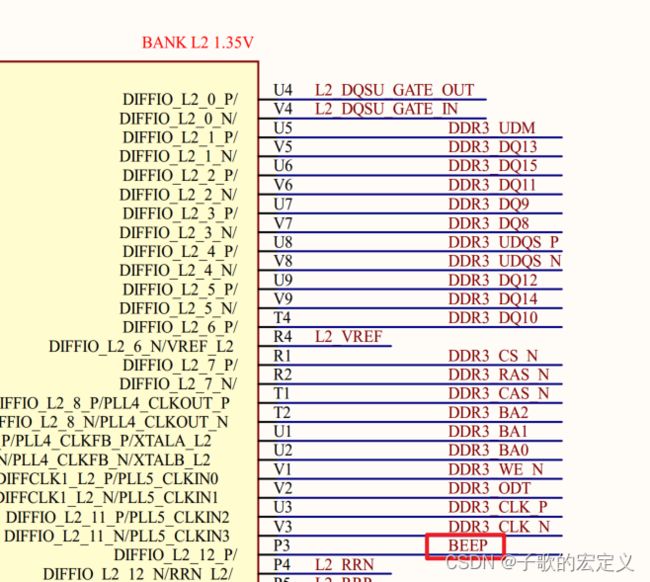FPGA-DFPGL22学习7-gpio
系列文章目录
FPGA-DFPGL22学习6-led
文章目录
- 系列文章目录
- 前言
- 一、原理图
-
- 1)key
- 2)beep+touch
- 端口对应
-
- 1)key
- 2)beep+touch
- 二、程序设计
-
- 1)KEY
- 2)beep+touch
- 三、程序编写
-
- 1.KEY代码:
- 2.beep+touch代码:
- 结论
前言
@和原子哥一起学习FPGA
开发环境:正点原子 ATK-DFPGL22G 开发板
参考书籍:
《ATK-DFPGL22G之FPGA开发指南_V1.1.pdf》
个人学习笔记,欢迎讨论
一、原理图
1)key
2)beep+touch
端口对应
1)key
define_attribute {p:key[0]} {PAP_IO_DIRECTION} {INPUT}
define_attribute {p:key[0]} {PAP_IO_LOC} {F2}
define_attribute {p:key[0]} {PAP_IO_VCCIO} {1.5}
define_attribute {p:key[0]} {PAP_IO_STANDARD} {LVCMOS15}
define_attribute {p:key[0]} {PAP_IO_PULLUP} {TRUE}
define_attribute {p:key[1]} {PAP_IO_DIRECTION} {INPUT}
define_attribute {p:key[1]} {PAP_IO_LOC} {H5}
define_attribute {p:key[1]} {PAP_IO_VCCIO} {1.5}
define_attribute {p:key[1]} {PAP_IO_STANDARD} {LVCMOS15}
define_attribute {p:key[1]} {PAP_IO_PULLUP} {TRUE}
define_attribute {p:key[2]} {PAP_IO_DIRECTION} {INPUT}
define_attribute {p:key[2]} {PAP_IO_LOC} {H6}
define_attribute {p:key[2]} {PAP_IO_VCCIO} {1.5}
define_attribute {p:key[2]} {PAP_IO_STANDARD} {LVCMOS15}
define_attribute {p:key[2]} {PAP_IO_PULLUP} {TRUE}
define_attribute {p:key[3]} {PAP_IO_DIRECTION} {INPUT}
define_attribute {p:key[3]} {PAP_IO_LOC} {G3}
define_attribute {p:key[3]} {PAP_IO_VCCIO} {1.5}
define_attribute {p:key[3]} {PAP_IO_STANDARD} {LVCMOS15}
define_attribute {p:key[3]} {PAP_IO_PULLUP} {TRUE}
2)beep+touch
#------------------------------touch-----------------------------------
define_attribute {p:touch} {PAP_IO_DIRECTION} {INPUT}
define_attribute {p:touch} {PAP_IO_LOC} {F1}
define_attribute {p:touch} {PAP_IO_VCCIO} {1.5}
define_attribute {p:touch} {PAP_IO_STANDARD} {LVCMOS15}
define_attribute {p:touch} {PAP_IO_PULLUP} {TRUE}
#-----------------------------------beep-----------------------------------------
define_attribute {p:beep} {PAP_IO_DIRECTION} {OUTPUT}
define_attribute {p:beep} {PAP_IO_LOC} {P3}
define_attribute {p:beep} {PAP_IO_VCCIO} {1.35}
define_attribute {p:beep} {PAP_IO_STANDARD} {LVCMOS15}
define_attribute {p:beep} {PAP_IO_DRIVE} {4}
define_attribute {p:beep} {PAP_IO_PULLUP} {TRUE}
define_attribute {p:beep} {PAP_IO_SLEW} {SLOW}
二、程序设计
1)KEY
想要实现的效果在流水灯的基础上按下一个按键后,对应的LED灯常量

2)beep+touch
三、程序编写
1.KEY代码:
代码如下(示例):
module flow_led(
input sys_clk, //系统时钟
input sys_rst_n, //系统复位
output reg [3:0] led,
input [3:0] key
);
reg [23:0] counter;
reg [3:0] led_contorl;
//时钟上升沿有效,复位信号下降沿有效
always @(posedge sys_clk or negedge sys_rst_n )begin
if (!sys_rst_n)
counter <= 24'd0; //非阻塞赋值,同时赋值
else if (counter < (24'd1000_0000 - 1'b1))
//else if (counter < (24'd10 - 1'b1))
counter <= counter + 1'b1;
else
counter <= 1'd0;
end
always @(posedge sys_clk or negedge sys_rst_n )begin
if (!sys_rst_n)
led_contorl <= 4'b0001;
else if (counter == (24'd1000_0000 - 1'b1))
//else if (counter == (24'd10 - 1'b1))
led_contorl <= {led_contorl[2:0],led_contorl[3]};
else
led_contorl <= led_contorl;
end
always @(posedge sys_clk or negedge sys_rst_n) begin
if (!sys_rst_n)
led <= 4'b0000;
else if (key != 4'b1111)
led <= ~key;
else
led <= led_contorl;
end
endmodule
2.beep+touch代码:
module top_all(
input sys_clk,
input sys_rst_n,
input touch_key,
output beep
);
wire key_flag;
key_module u_key_module(
.sys_clk (sys_clk ),
.sys_rst_n (sys_rst_n),
.touch_key (touch_key),
.key_flag (key_flag)
);
beep_module u_beep_module(
.sys_clk (sys_clk ),
.sys_rst_n (sys_rst_n),
.beep (beep),
.key_flag (key_flag)
);
endmodule
module key_module(
input sys_clk,
input sys_rst_n,
input touch_key,
output reg key_flag
);
reg key_reg0;
reg key_reg1;
wire key_en;
assign key_en = (~key_reg1)&(key_reg0);
always @(posedge sys_clk or negedge sys_rst_n) begin
if (!sys_rst_n) begin
key_reg0 <= 1'b1;
key_reg1 <= 1'b1;
end
else begin
key_reg0 <= touch_key; //非阻塞赋值,同时赋值
key_reg1 <= key_reg0;
end
end
always @(posedge sys_clk or negedge sys_rst_n) begin
if (!sys_rst_n) begin
key_flag <= 1'b0;
end
else begin
if (key_en) begin
key_flag <= ~key_flag;
end
end
end
endmodule
module beep_module(
input sys_clk,
input sys_rst_n,
output reg beep,
input key_value,
input key_flag
);
always @(posedge sys_clk or negedge sys_rst_n) begin
if (!sys_rst_n)
beep <= 1'b1;
else if (key_flag)
beep <= ~beep;
end
endmodule
结论
gpio的基本操作,学习到了如何使用不同文件的实例化






